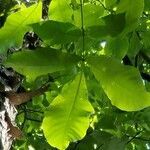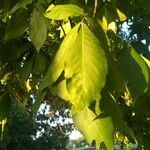Trees , to 46 m. Bark light gray, fissured or exfoliating, separating freely into long strips or broad plates that persist, ends often curling away from trunk. Twigs greenish, reddish, or orangish brown, retaining color or turning black on drying, stout or slender, hirsute or glabrous. Terminal buds tan to dark brown to black, ovoid, 6-18 mm, tomentose or nearly glabrous; bud scales imbricate; axillary buds protected by bracteoles fused into hood. Leaves 3-6 dm; petiole 4-13 cm, petiole and rachis hirsute or mainly glabrous. Leaflets (3-)5(-7), lateral petiolules 0-1 mm, terminal petiolules 3-17 mm; blades ovate, obovate, or elliptic, not falcate, 4-26 × 1-14 cm, margins finely to coarsely serrate, with tufts of hairs in axils of proximal veins of serrations, often weathering to only a few in fall, apex acute to acuminate; surfaces abaxially hirsute with unicellular and 2-4-rayed fasciculate hairs, occasionally restricted to midrib and major veins or essentially without hairs, with few to many large peltate scales and small round, irregular, and 4-lobed peltate scales. Staminate catkins pedunculate, to 13 cm, stalks and bracts without hairs; anthers hirsute. Fruits brown to reddish brown, spheric to depressed-spheric, not compressed, 2.5-4 × 2.5-4 cm; husks rough, 4-15 mm thick, dehiscing to base, sutures smooth; nuts tan, ovoid, obovoid, or ellipsoid, compressed, 4-angled, rugulose; shells thick. Seeds sweet.
More
A tall deciduous tree. It grows to 24-30 m high. It has a long straight trunk. The trunk can be 60 cm across. The crown is high and narrow. The bark is grey to brown and peels in long plates. The leaves are large and rich shiny green. They are 15-25 cm long. They have 5 broad leaflets. The leaflets are widest in the middle and taper to both ends. They are finely toothed. The leaves turn golden yellow in autumn. The flowers are separately male and female. The pollen flowers are in branched catkins at the base of new shoots. The female or seed flowers are in small clusters at the tips of new shoots. The fruit are almost round and 3-5 cm long. They occur singly or in pairs. The husk is thick and woody but the shell of the nuts is thin. The kernel is sweet and edible.
Bark light gray, soon separating into long plates; twigs stout, with a large gray bud; lfls 5, or 7 on sprouts, pubescent beneath when young, soon glabrate except for subapical tufts of hairs on the teeth, the terminal obovate, much larger and proportionately wider than the lateral; fr subglobose to broadly obovoid, mostly 3.5–5 cm; husk 3–12 mm thick, eventually splitting to the base; nut compressed, 2–3 cm, two-thirds as wide or wider, rounded at base, usually sharp-pointed; kernel sweet and edible; 2n=32. Rich, moist soil; s. Me. and s. Que. to se. Minn. and w. Neb., s. to Ga. and e. Tex.







